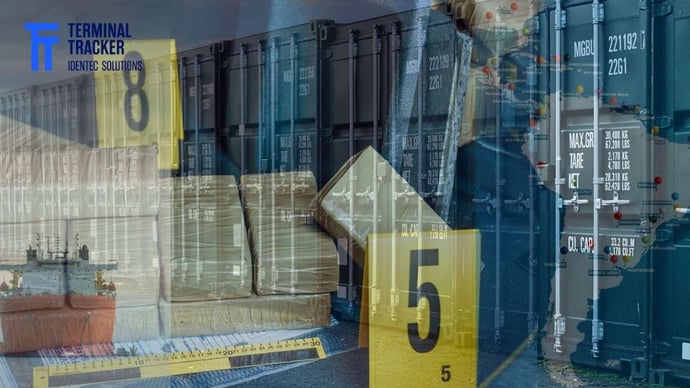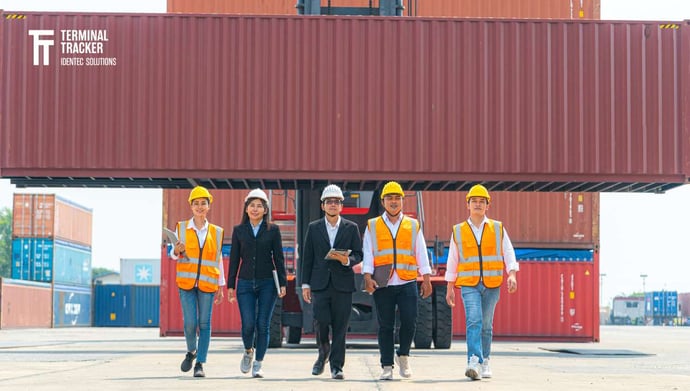Container Terminal Safety: The Challenge Called Drug Trafficking
| Written by Mark Buzinkay
When Identec Solutions embarked on bringing a traditional Position Detection System (PDS) to the market, we imagined the main motivating factors for purchasing would be keeping 100% yard stowage accuracy and the elimination of CHE operators' keystrokes.
In recent years we have seen many other incentivizing factors for our customers to deploy the solution. Ports and liners remain targets for organized crime to use the shipping container to distribute contraband material, whether illegal drugs, weapons, counterfeit goods or sanctioned commodities. Every day our website receives requests for information about how our products can help in this fight.
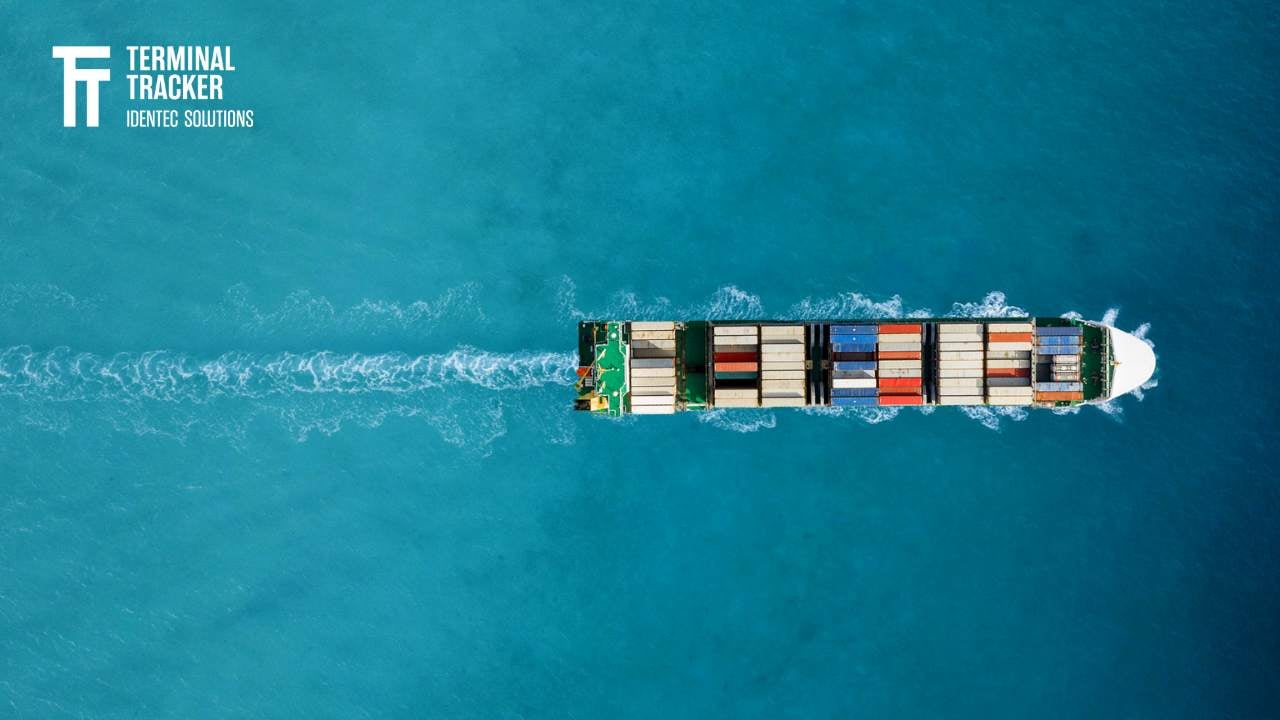
No video selected
Select a video type in the sidebar.
The containerization of trafficking
Globalization and international maritime commerce have provided traffickers with the perfect chance to reach global markets. Over the last twenty years, container shipping has become the most common form of trafficking into Europe. Every year, 750 million containers are shipped around the globe, but less than two per cent of these are ever inspected. From the narcotics traffickers' point of view, the challenge of this business model is to disguise large shipments to compensate for smaller seizures while maximizing profits.
Finding drugs in containers is a tricky task. Let's call it "the needle in a haystack", being the major advantage drug traffickers exploit. Less surprisingly, containers became the principal trafficking approach. When authorities discovered the security gap posed by container trafficking, they focused on shipping lines arriving from countries that were most commonly used for cocaine or opium shipments. Traffickers reacted by spreading out across the region, searching for new harbours that raised fewer suspicions (read more about the seizure of MSC Gayane).
In the case of cocaine smuggling, fanning out of usual hotspots like Colombian Turbo, Santa Marta, Cartagena, and Peruvian Callao is one approach of many. In the early years of across-the-sea trafficking, these ports were the no-brainer solution to basic economic questions: proximity to production zones, reliable connectivity with Europe, and established (local) criminal networks in these port towns. Today, they infested other ports in the region, heading to countries such as Ecuador, Costa Rica, Panama, the Dominican Republic, and above all, Brazil.
According to UNODC, the overall largest quantities of heroin and morphine captured in Western and Central Europe in 2018 were reported by Belgium, followed by France, Italy, the United Kingdom and the Netherlands. Although smuggling routes for heroin and morphine to Central Europe are along the Balkans by land, trafficking to Belgium in 2018, to a large degree, took the form of maritime shipments departing from Iran or Turkey. Similarly, the bulk of seizures in Italy in 2018 arrived from the Islamic Republic of Iran in containers. Shipments by air followed this, often leaving from the Middle East (Qatar) or Africa (South Africa), while heroin loads destined for France typically crossed the Netherlands and Belgium. UNODC estimates that during the pandemic and due to a massive reduction in air travel and tightening of borders within the EU, transportation by ship likely increased.
Another important trade route is the Pacific. The Pacific is the principal transit passage for the trafficking of drugs and chemical precursors bound from Asia and South America to Australia and New Zealand, where consumers pay some of the highest prices globally.
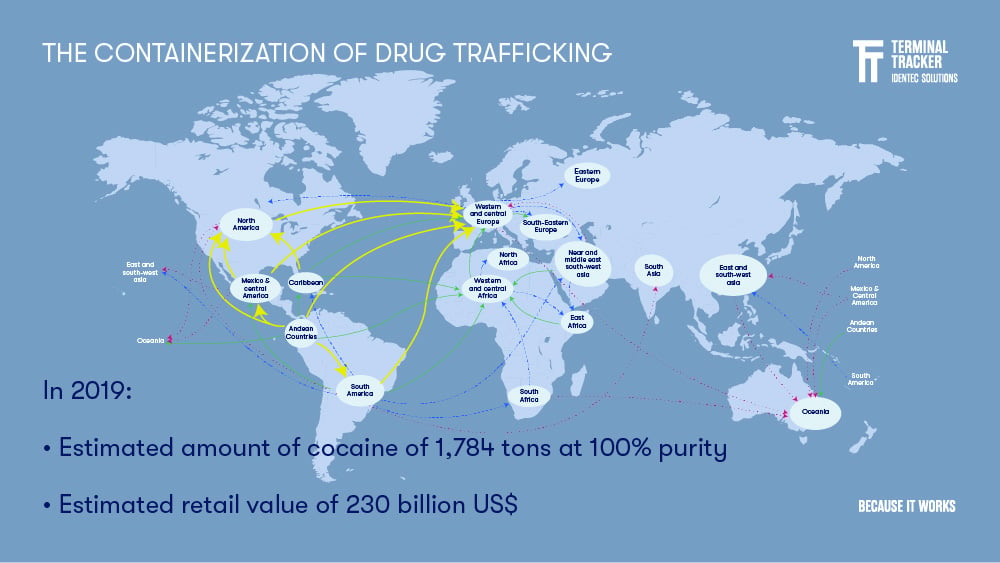
Container Terminal Safety in Jeopardy
Typically, traffickers run front companies, which they either set up themselves or buy, becoming the owners of businesses with a long history of clean exports. Subsequently, they hide the narcotics in their apparently legal exports (that's why it is called the "load technique"). Mainly, this involves simply stuffing little packs of drugs into boxes of cargo. Still, in other cases, traffickers have used everything from soaked clothes and pet food to barrels of hazardous chemicals to disguise them as "normal" products. In addition, the loading technique allows traffickers to have direct control over the shipment.
Authorities later answered the strategy of using non-traditional cocaine ports by profiling export companies looking for suspicious patterns. But unfortunately, their success drove traffickers to the rip-on/rip-off method: traffickers avoid profiling by using containers of other companies for their use. How do they do this? They break containers of legitimate exports open, deposit their drugs inside and seal the container with cloned customs seals to hide the tampering. Once the method proved to work, the shipments grew in size, with multi-ton hauls becoming commonplace.
In the case of the MSC Gayane, containers were broken off and re-sealed during travel onboard. In most cases, the containers are approached as they wait in the container terminal, meaning traffickers require access to the port. Slipping into the terminal area is one method. Still, it is far easier to recruit port workers to get - sometimes exclusive - access to the port most of the time. It virtually monopolizes trafficking from and to a particular terminal. In other cases, drug traffickers never penetrate the port. Instead, they bribe or threaten truck drivers and container yard workers to load drugs into containers on their way to the port or within the port. Corruption is the great enabler of organized crime, and opportunities for corruption exist at every phase of the drug supply chain.
If you're interested in sustainability and the supply chain, continue here...
Rip-on/Rip-off
When organised criminal groups organise cocaine trafficking via merchant ships, they usually use the "rip-on/rip-off" method. The UNODC describes this as a concealment method in which a legal shipment is exploited to smuggle drugs from the country of origin or the transhipment port to the destination country.
Bribery of crew members and port authorities is necessary for the operations to be successful. They act as intermediaries in the trade and allow access to the containers. Risk management experts say that in some countries, employees are repeatedly threatened with violence and have to play along. All major ports must take the warnings seriously, as the threat is also shifting to new, more complex, and less obvious routes.
Containers for perishable goods (refrigerated containers, so-called reefers) are often used, in which, for example, frozen food or fruit and vegetables are transported. In June 2023, for example, 3.6 tons of cocaine (worth 269 million Euros) were seized in the port of Rotterdam; they were hidden in a container of bananas from Ecuador.
The rip-on/rip-off techniques of some "clearers" are so perfected that they can remove 100 kg of cocaine from the container within 3 minutes. The container is opened and resealed without the sender or recipient even noticing that their cargo has been misused for the transport of drugs.
This can have far-reaching consequences for freight forwarders: ships that have transported containers in which drugs have been found can be detained by the authorities for closer inspection, which is a problem, especially for the perishable goods among their cargo. In addition to having an unpleasant impact on port operations, this also has an impact on customer confidence.
See also: our comprehensive container damage checklist
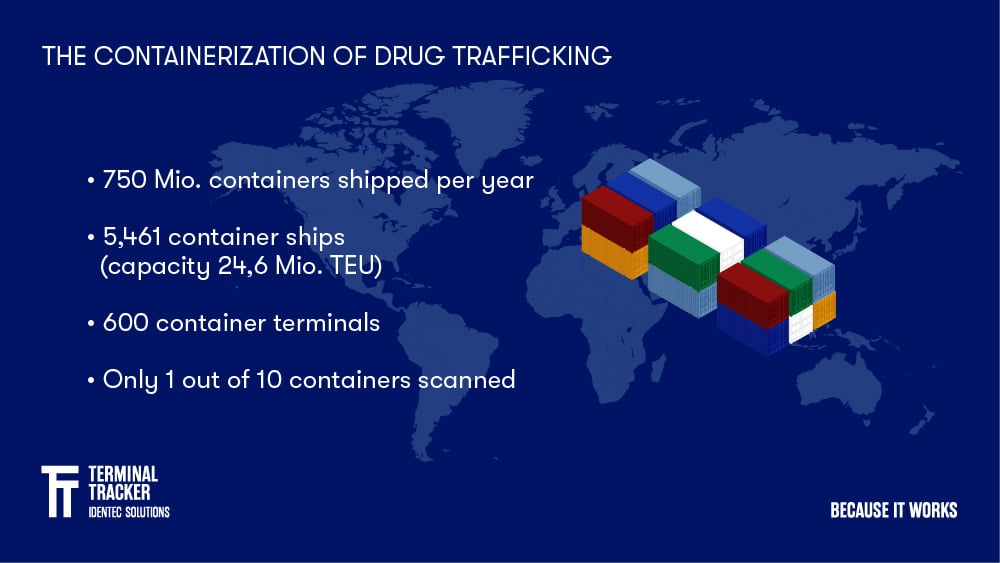
How can this situation change? Terminal Tracker is part of the answer.
The fallout of these new criminal dynamics became observable in high murder rates in these ports. Gang wars for control of the ports or killings of workers that resisted their authority seem commonplace. So the question is: How can this crisis change for the better? Some experts in both the public and private sectors see the solution in technology: so-called smart containers, which collect and transmit data on the container's geolocation, temperature fluctuations, and any other signs of tampering (check out our article about unreported container damage), or electronic customs seals, which send real-time information on the container movements. But what about ports where containers are waiting to be loaded or picked up (learn more about stolen cargo in container terminals)?
At its core, Terminal Tracker is all about position detection. By the addition of RF tags in OTR trucks and GPRS in Internal vehicles, operators know at all times whether or not people are following the normal expected behaviour required to execute pre-planned work instructions/jobs. In the past, there have been documented cases of drivers at a port going into what were previously "dark" corners of the yard to realize illicit activities. The use of Terminal Tracker has shined the light on these, and our customers can now quickly respond the moment something looks erratic in the CHE's Movement. At the same time, we have seen an increased interest in the number of Reefer Shippers who want end-to-end visibility through our 5G solution. By setting pre-defined traffic patterns from the farm/distribution centre to the port in our system, exporters can be alerted of deviations in this path. This has been a problem for one customer as containers were making "pit stops" to load contraband inside the reefer container before continuing to the port. (Learn more about container terminal automation)
The second security aspect is gates. Gates at terminals have long been known as choke points in the transactional container flow. The use of OCR, advanced appointment systems and other technologies have made it possible to speed up transactions tremendously in the last ten years. However, challenges remain in regard to what most ports consider a two-step authentication of container, driver and, in some cases, chassis. Terminal Tracker simplifies this process for many by using external truck and chassis tagging, which identifies the truck and equipment to the local TOS system. In some ports, further authentication can take place through the use of biometric readers. Most sites requiring biometric authentication have done so in response to drivers being hijacked along the road in an effort to enter the port and steal a container based on EIR printout or the use of an appointment number. The use of additional checks at the gate serves as a manner to discourage such criminal activity.
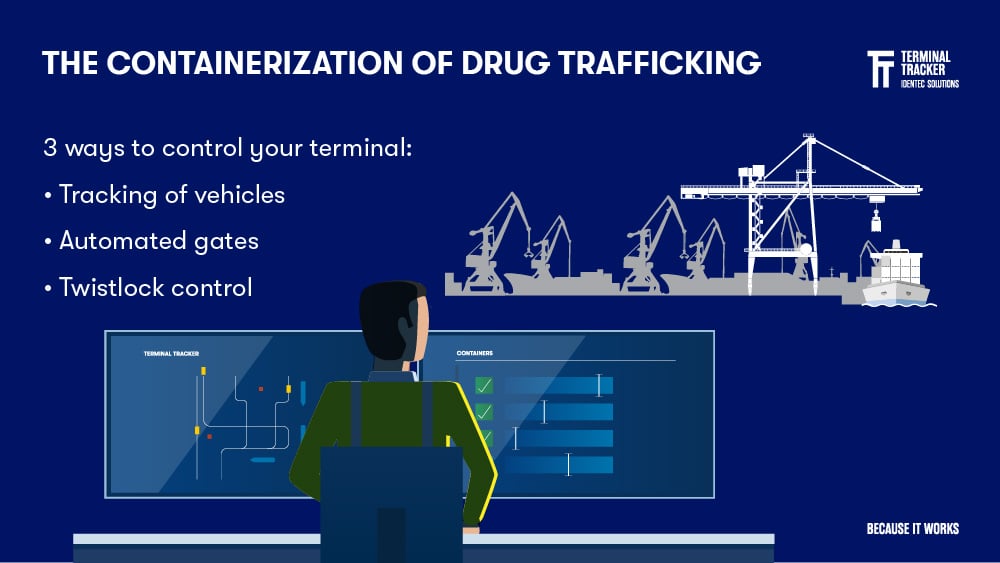
Twistlock Control and Weight Measured in Yard
In the past year, the use of Twistlock control has been vital in the fight against the narcotics trade for many of our customers. While utilizing a control that will not allow units to be put in anything other than the current planned position helps eliminate the use of so-called "Illegal Yard Moves", it is not a panacea to the problem. However, it does make things harder for the criminals and forces the focus and pressure to be placed on other parts of the supply chain deflecting some of the stress away from the CHE operators themselves.
At the same time, Identec Solutions can capture the measured yard weight and report it back to the TOS, whereby an analysis can be made between what was measured and what has been declared as the manifested weight. These discrepancies can often help governments identify intentional actions of either illicit cargo or tax fraud. Unfortunately, local and federal agencies are burdening these checks on the terminal operator to report such discrepancies. While this can be a daunting time-consuming calculation, it is something that our company can incorporate into the standard APIs that go between the equipment and the TOS system.
Takeaway
Ports and liners remain targets for organized crime to use the shipping container to distribute contraband material, whether illegal drugs, weapons, counterfeit goods or sanctioned commodities.
Technology can provide additional layers of safety, and experts see the solution in smart systems that track assets, grant access and enable machine availability to authorized personnel to avoid criminal
activities within the container terminal. And improving container terminal operations in general.
Dive into our extensive list of articles and white papers about port automation!
Glossary
Biometric readers are devices that capture and analyze unique physical or behavioral characteristics of individuals for identification and authentication purposes. These readers can scan various biometric traits such as fingerprints, iris patterns, facial features, or voice patterns. The captured data is then digitized and compared against stored templates to verify a person's identity. Biometric readers have become increasingly accurate and cost-effective, enabling their widespread adoption in developing countries for applications ranging from civil registries and voter identification to social transfer programs and financial services. (7)
GPRS (General Packet Radio Service) is a packet-switching protocol for wireless and cellular network communication. Introduced in 2000, it was the first widely adopted data transfer technology for 2G and 3G mobile networks. GPRS enables always-online functionality, allowing users to access mobile internet browsing, email, and messaging services. It offers speeds ranging from 40 to 115 Kbps, which was a significant improvement over its predecessor, GSM. Although considered outdated today, GPRS played a crucial role in the evolution of mobile data communication. (8)
Sources:
(1) James Bargent, Douwe den Held and Owen Boed (2021): Container Shipping: Cocaine Hide and Seek
https://insightcrime.org/investigations/container-shipping-cocaine-hide-and-seek/
(2) Jose Sousa-Santos (2022): Drug trafficking in the Pacific Islands: The impact of transnational crime
https://www.lowyinstitute.org/publications/drug-trafficking-pacific-islands-impact-transnational-
crime#sec45916
(3) Port Security Center: Drug trafficking - https://www.portsecuritycenter.eu/drug-trafficking/
(4) UNODC 2020 World Drug Report (2021) - https://www.unodc.org/res/wdr2021/field/WDR21_Booklet_4.pdf
(5) Vijitra Duangdee (2021): Asia-Pacific Drug Trade Thriving as Gangs Make Billions in Profits, UN Says
https://www.voanews.com/a/east-asia-pacific_asia-pacific-drug-trade-thriving-gangs-make-billions-
profits-un-says/6206848.html
(6) UNODC: South East Asia - UNODC Container Control Programme targets illegal maritime trafficking
https://www.unodc.org/southasia/frontpage/2014/Feb/south-asia_-unodc-container-control-
programme-targets-illegal-maritime-trade.html
(7) https://www.cgdev.org/publication/identification-development-biometrics-revolution-working-paper-315
(8) https://www.techtarget.com/searchmobilecomputing/definition/GPRS
Note: This article was updated on the 21st of January 2025

Author
Mark Buzinkay, Head of Marketing
Mark Buzinkay holds a PhD in Virtual Anthropology, a Master in Business Administration (Telecommunications Mgmt), a Master of Science in Information Management and a Master of Arts in History, Sociology and Philosophy. Mark spent most of his professional career developing and creating business ideas - from a marketing, organisational and process point of view. He is fascinated by the digital transformation of industries, especially manufacturing and logistics. Mark writes mainly about Industry 4.0, maritime logistics, process and change management, innovations onshore and offshore, and the digital transformation in general.


